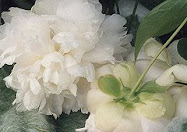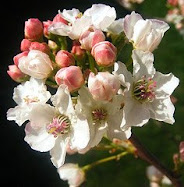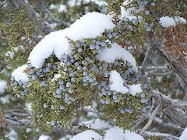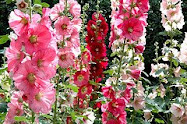 It's now the middle of June (even if the weather for the last few weeks has perversely behaved like mid-to-late October), the garden is in rampant, early summer flush of growth, so let's take a step back and review. After six years, which of the many flowering plants and herbs sown upon this sandy northwestern Michigan garden lot can be deemed successes? Nurseryman Dan Heims of Portland, Oregon writes, "Anywhere there is light, moisture and a bit of soil, there is life." Indubitably, those conditions pertain in these country parts with moist Lake Michigan air currents and silky, sunny summers, but which of the plants chosen and fostered don't merely live, but rock and roll?
It's now the middle of June (even if the weather for the last few weeks has perversely behaved like mid-to-late October), the garden is in rampant, early summer flush of growth, so let's take a step back and review. After six years, which of the many flowering plants and herbs sown upon this sandy northwestern Michigan garden lot can be deemed successes? Nurseryman Dan Heims of Portland, Oregon writes, "Anywhere there is light, moisture and a bit of soil, there is life." Indubitably, those conditions pertain in these country parts with moist Lake Michigan air currents and silky, sunny summers, but which of the plants chosen and fostered don't merely live, but rock and roll?The rollcall of standouts begins with the lavenders and thymes, who take to the sand-based soil like ducklings to water, and have needed only hard trim-back each late autumn to grow denser and spread further each summer, with an extravagant harvest of flowers every year. Even in the most parched summers, these herbs never received watering to supplement the rainfall, a hands-off approach that has suited them to a tee, as well as making the gardener's chores much easier.
Hollyhocks and peonies likewise needed only to be given houseroom in a hole, tucked roundabout with chocolate-cake texture composted cow manure, and watered weekly their first summer to infuse their roots with get-up-and-go. Now they bound up and shake out very full tail feathers each spring, each one adding their particular green hedging to the borders. The only quibble here is with the dark red peonies, as unlike their pastel sisters, they don't develop very many flower buds, some years only one flower or even none per plant. This is the second summer the dark reds have grown thick, healthy leafage, but minimal flowers, I've no idea why. Perhaps the "eyes," those reddish shoots at the bottom of the plant, didn't get enough light under their winter mulch, this fall we'll try leaving them less covered-up.
The dark plum and the butter-and-cream Siberian iris are doing excellent, filled with tightly furled flower heads. If the sun actually consents to shine for a few days in a row, the iris will be blooming by month's end. Likewise for the vigorous beds of mixed poppies, lots of round, full buds on those, as well. The poppies took a couple years of leading by the hand to get themselves in growing and blooming gear. All were started from seed, some package and some from friends' gardens. The first year planted (whether sown in spring or fall), they barely put up stalks and leaves, with a sparse or no show of flowers. They've come on nicely and multiplied their numbers each year, however, this summer bearing more flower buds than any prior year.
Another entry that took a couple years to hit their stride are the lupines. Also brought along from seed, the two lupine patches are now in their third year and absolutely brimming with the tall, columnar, purple and peach flowers, with their ferny leaf bracts as wide around them as a debutante's tulle ruffles. The lupine flower is handsome, distinctive and somehow mysterious in its shapely form, and compensates very well for the absence of its somewhat similarly shaped cousin, the foxglove, which has repeatedly, politely declined to flower or perennially or biennially return to the garden, despite having been given numerous handmade invitations to do so.
The echinops globe thistle have filled and spill over a section of a flower bed where globe amaranth gomphrena were tried, struggled, fared poorly, and were ultimately abandoned as a bad cause. Another plant that takes virtually no watering to raise their proud and dapper lakewater-blue heads, the globe thistles will bring welcome color to the garden in July and August, when many of the other flowers are flagging or spent. They are kept company in their bed by penstemons, enthusiastically fanning out in only their second year in residence, and a mountain bluet centauria, which has flowered like there's no tomorrow all through this month and is still going gangbusters, setting up new flower buds.
Chives, snow-in-summer, snow-on-the-mountain, delphinium, the half-dozen rose bushes, lilly-of-the-valley and day lillies, phlox, muscari, crocosmia lucifer, daisies, rock cress, violets, stonecrop sedum, baby's breath, verbascum, and pretty, frilly little veronica waterperry, one and all have found their way back to the garden again this year, in greater size and strength. The dianthus pinks can also be said to be here to stay. They annually push the edges of their carpeting green foliage farther in diameter, but this year, for the first time, they haven't flowered very profusely, offering only a smattering of blooms. Lashings of composted cow manure, the richest natural fertilizer available, are definitely in store for them, come the autumn. Some of the creeping phlox swatches, especially the paler pink-shaded and variegated, also managed only a weak flower display this May, perhaps due to the colder-than-normal temperatures and rather niggling number of sunny days, or maybe because fallen birch and pear leaves weren't sufficiently cleaned off of them last fall. This autumn, fingers crossed and hand on heart, they will get a thorough raking over and fertilizing. Please may this return them next spring to their normal mad fandango of brilliant flower display.
When all's said and done, and with the tiny sprouts emerging of seeded rudbeckia, sunflowers, cosmos, bachelor buttons, chamomile and asters, the garden is full of vim and vigor, and looks pretty darn marvelous to me. In every direction there is color and enterprise, zeal and coquetry, energy and finery for the eyes to feast upon. The garden in June, after the long pewter and slate of a relentless Michigan winter, opens a crayola box of hue and possibility, life indeed, life aplenty.









No comments:
Post a Comment